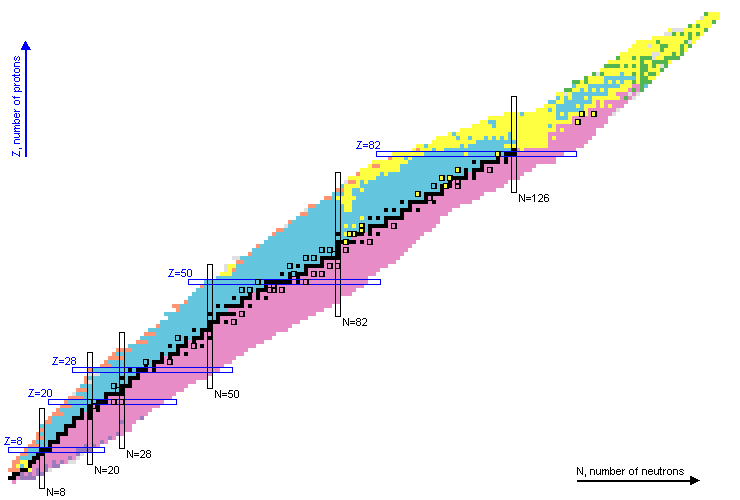Alpha Decay
Overview
The atomic nucleus is composed of protons and neutrons, yet 2 of the protons and 2 of the neutrons can group to form an α particle inside the nucleus, that is, to form a 4He nucleus. The escape of an α particle is known as α decay.
α particles feel an attractive force from the combined proton and neutrons, however, the protons will also exert a repulsive force due to Coulomb interaction. Additionally, the α particle angular momentum will push it towards the surface of the nucleus.
In α decay, the original nucleus with Z proton, N neutrons, and A total of nucleons will lose 2 protons, 2 neutrons and a total of 4 nucleons:
α decay: (Z,N,A) -> (Z-2,N-2,A-4)
Decay Energy
The energy available for the decay is known as α- decay Q-value. For transitions between nuclear ground states it is calculated as:
α- decay Q-value=Mass(Z,N) - Mass(Z-2,N-2) - Mass(α)
Numerical values can be obtained from the web application QCalc.
Chart Region
α decay typically occurs for heavy nuclei, Z larger than 50. Nuclei that exhibit α decay are indicated with a yellow background in the chart of nuclei:

α decay half-lives can span the whole range of known values, from very short to very long. The larger the energy available for the decay, the shorter the half-life. Additionally, nuclear levels with similar values of spin and parity to the initial level are preferentially populated. The larger the difference in angular momentum the larger the half-life, yet this dependence is not as strong as it is for β and proton decays.
Hinderance Factor
A quantity often used is the "Hindrance Factor", which is the ratio between the alpha-decay partial experimental half-life and a calculated half-life, for instance that obtained using Preston's model :
HF = T1/2 (experimental)/ T1/2(calculated)
The relation between Hindrance Factors values and T1/2 has been studied in detailed by Akovali.
Additional Resources
Database Manager and Web Programming:
Alejandro A. Sonzogni
sonzogni@bnl.gov
Navigation
